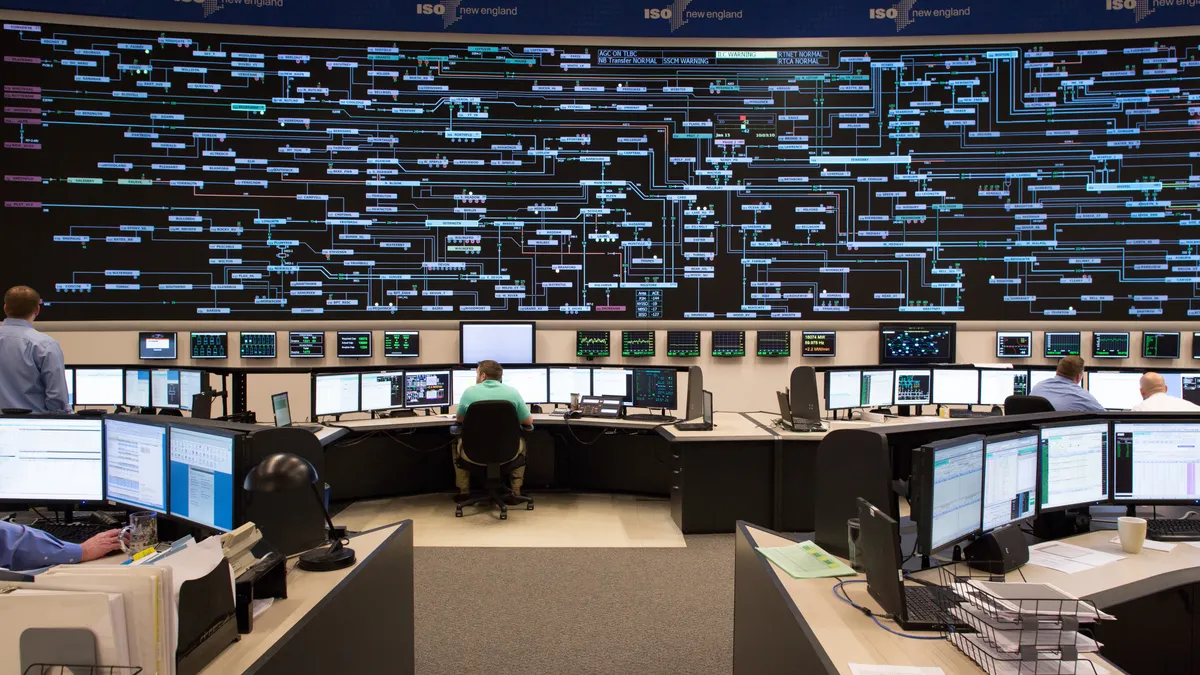Dive Brief:
- The reserve margin on the ISO New England system may need to increase from about 15% to 300% by 2040 in some scenarios, as more renewables are added and dispatchable generation is retired to meet state clean energy goals, according to a July 29 report from the grid operator.
- The first phase of the ISO’s Future Grid Reliability Study models a variety of decarbonization scenarios in 2040 and concludes they “may require a significant amount of gas or stored fuels to support variable resources.”
- A scenario where reliability criteria are met using only solar, wind and storage, would challenge the transmission system and require “an outsized amount of land or offshore areas” for wind and solar farms, the report found.
Dive Insight:
The addition of new transportation and building electrification loads as part of deep decarbonization efforts will shift the grid to a winter-peaking system and require changes to planning processes, the ISO said.
A deep decarbonization scenario with heavy renewable penetration and large electrification load results in the region’s grid “moving to a winter peaking grid, with reliability hours in the pre-dawn winter morning in addition to the evening. As the region transitions, reliability assessments will need to be conducted on a 12-month basis instead of seasonally,” the report said.
The study is the product of a joint effort by the ISO, the New England states, and the New England Power Pool, known as the Future Grid Initiative, which models the future of the region’s energy system based on state climate goals and laws.
In the next step, the ISO said it plans to issue a trio of appendices later this year to address production cost, ancillary services, and resource adequacy. A second phase of the Future Grid Reliability Study will consider the role of wholesale electricity markets.
The study’s deep decarbonization scenario includes the addition of 16 GW of offshore wind, 28 GW of solar, 600 GW of battery storage systems and new transmission, and is based in part on assumptions used in Massachusetts’ 2050 Deep Decarbonization Roadmap Study. In this scenario, heating and transportation make up 20% and 18.6% of the ISO’s total load, respectively.
A moderate decarbonization scenario, with assumptions based on a 2020 economic study requested by National Grid, included the retirement of all remaining coal units and some other fossil fuel generation, and added 8 GW of offshore wind, 2 GW of battery storage, and new transmission. It also assumed solar capacity will increase to 15.8 GW, and heating and transportation make up 5.8% and 4.4% of the total load, respectively.
The ISO says its study illustrates how a diverse array of generation will be required to reliably meet electricity demand. A modified version of the deep decarbonization scenario utilizing only only wind, solar and storage, would require 89,900 MW of those resources. ISO-NE currently has only 5,600 MW.
“This scenario would require such a large amount of wind and solar that it may present significant challenges the transmission system and require an outsized amount of land or offshore areas to be sited and developed for the necessary wind and solar farms,” the report warned.
Substituting 3,000 MW of dispatchable units, “which could be fulfilled by a variety of potentially emission-free technologies,” the report said, would reduce necessary new wind, solar and storage by 17,000 MW, or 19%.
The report describes those units as “hypothetical dispatchable emission-free resources.”
The New England grid study “underlines the importance of ensuring that reliability is maintained,” Dan Dolan, president of the New England Power Generators Association, said in an email. “The New England electricity market must continue to be improved [and] focused on reliability and a durable platform for ongoing investments in regional generation resources.”
Failing to invest in generation means “consumers will absorb greater risk and growing costs over time,” Dolan said.














